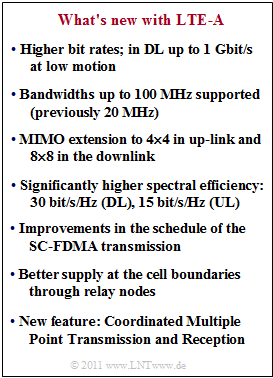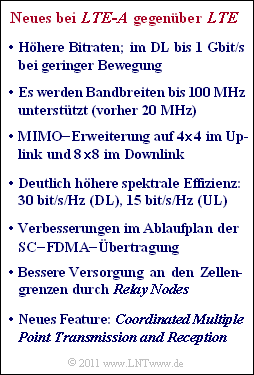Exercise 4.5: LTE vs LTE-Advanced
In summer 2011, LTE is now on the verge of commercial use, and construction and expansion work is currently underway in more and more major cities. Even if - as with previous standards - it will still take some time before all interested parties can enjoy the benefits of this fourth-generation mobile communications system: $ {\rm LTE}$ is on the advance.
At the same time, the successor ${\rm LTE-Advanced}$ (LTE-A for short) has already reached the final stage of specification.
- In comparison to LTE, the speeds here are more than tripled, roughly speaking.
- This shows that even in 2011 - almost 20 years after the initial euphoria - Moore's Law can still be applied to mobile communications.
- Continuing technical development can be expected.
Notes:
- The task belongs to the chapter LTE-Advanced - a further development of LTE.
- The above graphic shows some of the innovations in the transition from LTE to LTE-A.
- In addition to LTE and LTE-Advanced, other newer standards such as WiMAX and UMB (Ultra Mobile Broadband) are also referred to.
$\text{################################################################}$
Im Sommer 2011 steht nun LTE kurz vor der kommerziellen Nutzung und in immer mehr Großstädten wird derzeit mit dem Auf– und Ausbau begonnen. Auch wenn – ähnlich wie bei vorherigen Standards – noch einige Zeit vergehen wird, bis alle Interessenten die Vorzüge dieses Mobilfunksystems der vierten Generation werden nutzen können: $ {\rm LTE}$ ist auf dem Vormarsch.
Gleichzeitig ist bereits der Nachfolger ${\rm LTE–Advanced}$ (kurz LTE–A) in der Endphase der Spezifizierung angekommen.
- Im Vergleich zu LTE werden hier die Geschwindigkeiten grob gesprochen mehr als verdreifacht.
- Dies zeigt, dass sich auch im Jahr 2011 – fast 20 Jahre nach der ersten Euphorie – Moore’s Law noch auf den Mobilfunk anwenden lässt.
- Mit einer kontinuierlichen technischen Weiterentwicklung ist zu rechnen.
Hinweise:
- Die Aufgabe gehört zum Kapitel LTE–Advanced – eine Weiterentwicklung von LTE.
- In obiger Grafik sind einige der Neuerungen beim Übergang von LTE auf LTE–A zusammengestellt.
- Bezug genommen wird außer auf LTE und LTE–Advanced auch auf andere neuere Standards wie WiMAX und UMB (Ultra Mobile Broadband).
$\text{################################################################}$
Questionnaire
$\text{################################################################}$
Fragebogen
$\text{################################################################}$
sample solution
(1) Correct are the answers 3 and 4. LTE-B and LTE2 are pure fantasy names.
- Ultra Mobile Broadband (UMB) is a competitor to LTE, but is considered to be third generation.
- It was specified by 3GPP2 (Third Generation Partnership Project 2), while LTE goes back to 3GPP (Third Generation Partnership Project).
- The 3GPP2 was founded almost at the same time as the almost named 3GPP in December 1998, apparently due to unbridgeable ideological differences.
- The success of UMB, however, seems to be more than questionable - at least in Europe - because even its predecessor cdma2000', for which the term W-CDMA is also common, plays almost no role anymore.
- Worldwide Interoperability for Microwave Access (WiMAX) is a synonym for radio systems according to the IEEE standard 802.16. These are also intended to compete with LTE in a mobile variant.
- According to developers, there are currently (2011) already almost 600 WiMAX-based radio networks in 150 countries.
(2) Correct are the answers 1 and 4:
- The relay nodes are quasi additional base stations at the edges of the cells and ultimately ensure improved service quality, as interruptions when switching between cells become less frequent.
- At the same time they increase the range.
(3) Correct are the answers 2, 3 and 5:
- The most limiting factor for the data rate that can actually be achieved is that the users of mobile radio systems generally have to share the available bandwidth.
- This is called „Shared Medium”. Voice connections slow down the network. In small cells without voice users, however, one almost reaches the specified rate.
- But also shielding by walls or other obstacles lead to a lower data rate.
- The hardware, on the other hand, is already sufficiently available today to actually achieve the theoretically possible transmission rates. Older devices will not be able to achieve the full speed, however.
(4) The only correct answers are Answers 1:
- WiMAX is specified in two different standards, a mobile one, which offers a high range with still comparatively high data rates, and a stationary one, which for example has a range six times higher than WLAN in a typical urban scenario and thus wants to compete with this standard.
- The achievable data rates of WiMAX and LTE are similar.
- Answer 3 is explicitly wrong: The German government supports LTE, not WiMAX.
$\text{################################################################}$
(1) Richtig sind die Antworten 3 und 4. LTE–B und LTE2 sind dagegen reine Phantasienamen.
- Ultra Mobile Broadband (UMB) stellt einen Konkurrenzentwurf zu LTE dar, wird aber der dritten Generation zugerechnet.
- Es wurde vom 3GPP2 (Third Generation Partnership Project 2) spezifiziert, während LTE auf 3GPP (Third Generation Partnership Project) zurückgeht.
- Das 3GPP2 wurde nahezu zeitgleich mit dem fast namensgleichen 3GPP im Dezember 1998 gegründet, offenbar aufgrund von unüberbrückbaren ideologischen Differenzen.
- Der Erfolg von UMB erscheint aber – zumindest in Europa – mehr als fraglich, denn schon der Vorgänger cdma2000, für den auch die Bezeichnung W–CDMA gebräuchlich ist, spielt so gut wie keine Rolle mehr.
- Worldwide Interoperability for Microwave Access (WiMAX) ist ein Synonym für Funksysteme nach dem IEEE-Standard 802.16. Diese sollen in einer mobilen Variante LTE ebenfalls Konkurrenz machen.
- Laut Auskunft der Entwickler gibt es derzeit (2011) schon fast 600 auf WiMAX basierende Funknetze in 150 Ländern.
(2) Richtig sind die Antworten 1 und 4:
- Die Relay Nodes sind quasi zusätzliche Basisstationen an den Zellenrändern und sorgen im Endeffekt für eine verbesserte Servicequalität, da damit Unterbrechungen beim Wechsel zwischen Zellen seltener werden.
- Gleichzeitig erhöhen sie die Reichweite.
(3) Richtig sind die Antworten 2, 3 und 5:
- Der am stärksten begrenzende Faktor für die tatsächlich erreichbare Datenrate ist, dass sich die Nutzer von Mobilfunksystemen die zur Verfügung stehende Bandbreite generell teilen müssen.
- Man spricht von einem „Shared Medium”. Sprachverbindungen bremsen das Netz aus. In kleinen Zellen ohne Sprachnutzer erreicht man allerdings fast die angegebene Rate.
- Aber auch Abschirmungen durch Wände oder andere Hindernisse führen zu einer geringeren Datenrate.
- Die Hardware steht hingegen schon heute ausreichend zur Verfügung, um die theoretisch möglichen Übertragungsraten auch wirklich zu erreichen. Ältere Geräte werden die volle Geschwindigkeit allerdings nicht leisten können.
(4) Richtig ist nur die Antworten 1:
- WiMAX ist in zwei verschiedenen Standards spezifiziert, einem mobilen, der eine hohe Reichweite bei weiterhin vergleichsweise hohen Datenraten bietet, sowie einem stationären, der beispielweise in einem typisch urbanen Szenario eine sechsmal höhere Reichweite als WLAN besitzt und diesem Standard somit Konkurrenz machen will.
- Die erreichbaren Datenraten von WiMAX und LTE sind ähnlich.
- Die Antwort 3 ist ausdrücklich falsch: Die Bundesregierung unterstützt LTE, nicht WiMAX.

